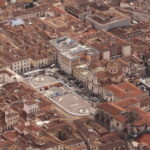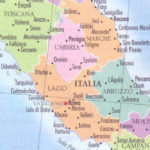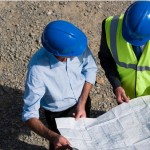L’allarme del New York Times: “Le citta’ ci mettono secoli per svilupparsi, ma possono morire in un batter d’occhio”
I soccorsi di emergenza sono stati straordinari. Volontari provenienti da tutta Italia si sono precipitati ad aiutare. Villaggi di tende sono stati rapidamente costruiti al di fuori della zona di pericolo. Sono stati organizzati concerti di ogni genere per alzare il morale e la speranza mentre venivano costruiti decine di nuovi complessi residenziali nella periferia della citta’.
Ma ora, il futuro a lungo termine di L’Aquila e’ messo in dubbio. La scarsezza di fondi, di volonta’ politica e di attenzione internazionale, minacciano di completare ciò che il terremoto ha iniziato.
Questa non sarebbe la prima citta’ italiana a non essere ricostruita dopo un terremoto. Dopo un terremoto che colpì la Sicilia, i centri storici sono stati abbandonati ed i sopravvissuti sono stati sistemati tutti in alloggi di emergenza inizialmente pensati per essere di breve termine per poi diventare permanenti, per impostazione predefinita e di abbandono. L’Aquila deve fare meglio.
“In un paese distratto dai problemi del suo primo ministro – scrive il Nyt – il successo delle operazioni di soccorso ha paradossalmente generato la convinzione che l’Aquila non abbia più bisogno di altro aiuto”.
In assenza di una leadership forte e di una guida guida, in assenza di leggi urbanistiche o forum pubblico dove i cittadini possano seriamente fare i conti con il futuro dell’Aquila, c’e’ solo il senso nascente che l’opportunita’ stia scivolando via.
L’articolo completo del New York Times
An Italian City Shaken to Its Cultural Core
Cities take centuries to grow, but they can die in the relative blink of an eye.
After an earthquake in April killed hundreds and left tens of thousands homeless in and around this medieval and Baroque city some 70 miles northeast of Rome, the emergency relief efforts were extraordinary. Volunteers from all over Italy rushed to help. Tent villages were swiftly set up outside the danger zone. Concerts were staged to provide continuity and hope, and construction workers were soon erecting dozens of housing complexes on the outskirts of town.
But now, as the region’s mayors and the Italian culture ministry prepare to take over recovery efforts from emergency agencies in January, the longer-term future of L’Aquila is in question. Shortages of money, political will, architectural good sense and international attention — along with a distinctly Italian predilection for a kind of magical thinking — threaten to finish what the quake started.
This would not be the first Italian city that didn’t recover from an earthquake. After a quake struck Sicily during the 1960s, historic centers were abandoned, surviving if at all only in name through the shabby buildings thrown up to provide short-term housing, which became permanent by default and neglect. L’Aquila should fare better. Efforts are being made to save the roughly 110,000 monuments and artifacts the culture ministry estimates were affected in the quake.
But ministry officials guess that it will take 10 or 15 years to return the historic center back to normal, whatever that will mean, and nearly all rebuilding, including of private houses, will meanwhile have to get approval from the ministry, a painstaking process.
Before the earthquake about 10,000 people lived in the city center, and another 60,000 nearby. After a decade or more of being displaced, those who once lived in the heart of L’Aquila may no longer be around or want to return, and the housing built for them in the surrounding industrialized area — so far, 150 steel-wood-and-concrete buildings have gone up — may have changed the area beyond recognition. A gracious medieval city onto which a Baroque one had been precariously balanced (the precariousness partly accounted for the extent of damage during the quake), L’Aquila was also a commercial and cultural hub, a university town. In a few years, if the center remains dead, it could devolve into nothing more than a second-tier tourist site in the midst of undifferentiated sprawl.
Any recovery, especially a speedier one, depends on billions of dollars (at least $16 billion, by various estimates) turning up mostly via the Italian Parliament. Lately even a small excise tax to aid recovery, proposed by the mayor of L’Aquila and various culture officials, went nowhere. In a country pressed for cash and distracted by the tabloid travails of its prime minister, the success of the emergency efforts has paradoxically fed the impression that L’Aquila no longer needs urgent help. As Michela Santoro, an assistant to the city’s mayor, Massimo Cialente, put it the other day: “The message in the media here is, ‘Things are going well.’ That is far from the truth.”
Mr. Cialente, for his part, has been busy ushering reporters and television crews in and out of his makeshift office in a former school on the outskirts of the city, broadcasting the same grim message.
“If we don’t reconstruct properly” — meaning, from his perspective, to put everything back exactly as it was, albeit seismically secured — “it will be a shame on the entire nation. We will have another Pompei.”
That’s a typical lament here. Italians often think they must restore the past or end up consigned to it. Alternatives are hard to imagine.
Roberta Pilolli works for L’Aquila’s music conservatory. After the quake she helped lug the conservatory’s grand pianos from the rubble. L’Aquilans take pride in being tough.
The other afternoon, in sweatshirt and sneakers, she was preparing for the official opening, this week, of the school’s new quarters, an $8 million metal-and-glass building in the sprawl beyond the center, built in just over a month.
“I want my home back exactly as it was,” Ms. Pilolli said. She was talking about her small, prewar terrace house in the city center, where her family lived for ages — not an architectural treasure, but that was beside the point. “It is my identity,” she added. “Now L’Aquila is dead, and they’re only caring about churches and monuments, not about our houses. But the whole city was a monument.”
Referring to the new government-built apartment buildings, which are akin to the new conservatory, Aldo Benedetti, a professor of architecture in L’Aquila, elaborated: “They have no context, no idea of architecture, only the feel of army barracks, plunked somewhere.”
Pier Luigi Cervellati, an urban planning professor in Venice, goes further. He said recovery should focus on returning residents to the center more quickly, not on providing alternative housing, or on churches and monuments or malls and commerce. “A center that is left empty for years dies,” he said. “These new homes they’re building on the outskirts are very expensive and make no urban sense. They’re like terminals at an airport. They have no soul. The risk is that the center will become a nonplace.”
Residents in the new apartments, grateful at first to have someplace, are already grousing about the lack of space, shops, sports fields and any social organization. It doesn’t take long after a disaster like the one here before gratitude yields to impatience and distrust. Rumors about corruption and kickbacks are naturally rampant. The music conservatory cost nearly three times more than a proposed $3 million conservatory with concert hall by Shigeru Ban, the noted Japanese architect. L’Aquilans like Mr. Benedetti, the professor, have been wondering why.
What’s the solution? Even while bombs were falling on London during the Blitz in 1940, British planners were conjuring up visions of a new postwar London. Calamity became an opportunity to dream. In the absence of a strong, guiding leadership, strong urban planning laws or public forums where citizens might seriously grapple with a future L’Aquila, there is only the dawning sense that opportunity may be slipping away. But opportunity still exists, perhaps to embrace new architecture alongside old, as L’Aquila did after the earthquake in 1703, when the city became the beloved Baroque one everyone now wants to preserve as if it had always been there. Never a perfect city but a real, living one, L’Aquila might yet become the model for a new sort of 21st century historic center in Italy.
But time is fleeting. Recently, visiting the ruined parish Church of Santa Maria Paganica where the roof is gone and a surreal mountain of rubble inside rises toward the clerestory windows, I watched while an archeologist for the culture ministry, cataloging every broken shard, wasted half an hour in the freezing cold and snow, arguing with Michelangelo Saporito, a firefighter working for the emergency services. Mr. Saporito, from Sicily, came in May, five days after his second child was born. He wanted to help. This morning he was showing the church to a visitor, as he had already done several times that day with other visitors.
But he had forgotten to bring along the usual permission slip. Bureaucracy and the wrong priorities bogged down progress.
It seemed like a metaphor.
Mr. Saporito sighed.
“You see the problem,” is how he put it.























 6APRILE.IT E' UN BLOG SENZA SCOPO DI LUCRO! sul terremoto che ha ucciso 309 persone a L'Aquila il 6 aprile 2009. Viene aggiornato senza alcuna periodicità e pertanto non è da considerarsi una testata giornalistica o in ogni caso un prodotto editoriale ai sensi della legge n.62 del 7.3.2001. L'obiettivo è quello di ricordare le vittime e sostenere le persone che stanno ancora affrontando gli effetti di quella tragedia e dei successivi terremoti del 2016 e del 2017. Tutte le immagini di questo sito sono ampiamente diffuse su Internet e sono qui utilizzate senza alcuno scopo commerciale; non è intenzione di questo sito appropriarsi indebitamente dei contenuti protetti da diritto d'autore, quindi se detenete il copyright di qualsiasi contenuto, contattateci e (secondo vostra indicazione) lo rimuoveremo o ne indicheremo l'autore. Un ringraziamento speciale a tutte le persone che aiutano questo sito a restare in vita.
6APRILE.IT E' UN BLOG SENZA SCOPO DI LUCRO! sul terremoto che ha ucciso 309 persone a L'Aquila il 6 aprile 2009. Viene aggiornato senza alcuna periodicità e pertanto non è da considerarsi una testata giornalistica o in ogni caso un prodotto editoriale ai sensi della legge n.62 del 7.3.2001. L'obiettivo è quello di ricordare le vittime e sostenere le persone che stanno ancora affrontando gli effetti di quella tragedia e dei successivi terremoti del 2016 e del 2017. Tutte le immagini di questo sito sono ampiamente diffuse su Internet e sono qui utilizzate senza alcuno scopo commerciale; non è intenzione di questo sito appropriarsi indebitamente dei contenuti protetti da diritto d'autore, quindi se detenete il copyright di qualsiasi contenuto, contattateci e (secondo vostra indicazione) lo rimuoveremo o ne indicheremo l'autore. Un ringraziamento speciale a tutte le persone che aiutano questo sito a restare in vita. 6APRILE.IT IS A NON-PROFIT BLOG! about the earthquake which killed 309 people in L'Aquila, Italy, on 6 april 2009. The aim is to remeber the victims and to support local popuation which is still facing the effects of that tragedy and of the subsequent 2016 and 2017 earthquakes. All pictures and other media on this site are widely spread on the internet and are used here without any commercial purpose; it is not the intention of this site to misappropriate copyrighted content, so if you own the copyright of any content, just contact us and we will remove it. Special thanks to all the people who help in keeping this website alive.
6APRILE.IT IS A NON-PROFIT BLOG! about the earthquake which killed 309 people in L'Aquila, Italy, on 6 april 2009. The aim is to remeber the victims and to support local popuation which is still facing the effects of that tragedy and of the subsequent 2016 and 2017 earthquakes. All pictures and other media on this site are widely spread on the internet and are used here without any commercial purpose; it is not the intention of this site to misappropriate copyrighted content, so if you own the copyright of any content, just contact us and we will remove it. Special thanks to all the people who help in keeping this website alive.